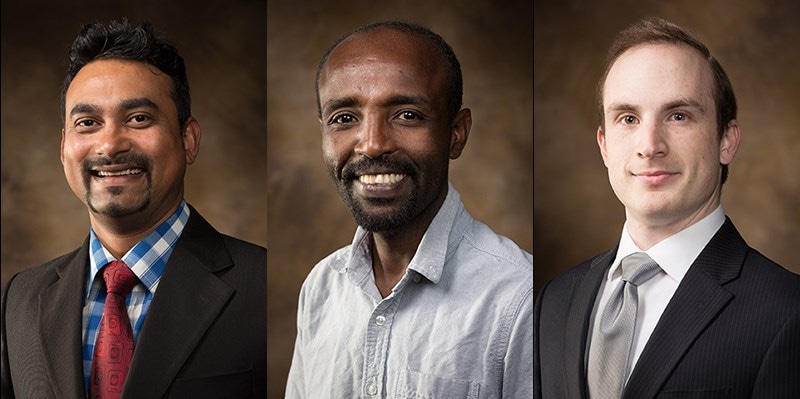May 24 2017
Scientists at the University of Arkansas have successfully performed a study for elucidating the optical characteristics of plasmonic nanostructures. This research can open the door for developing enhanced sensors applied in security and biomedical devices, as well as in solar cells. The Researchers from the Department of Physics recently reported the outcomes of the research in the PLOS ONE journal.
 From left: Pijush K. Ghosh, Desalegn T. Debu and David A. French. (Photos by Whit Pruitt, University Relations)
From left: Pijush K. Ghosh, Desalegn T. Debu and David A. French. (Photos by Whit Pruitt, University Relations)
The frequency of plasmons, or electronic waves on the surface of a metal, can be modified to couple with light by altering the particle material, shape, size, as well as surrounding environment. The plasmons have the ability to enhance light intensity and focus the light down to nanoscale magnitudes, which is applicable for a range of nanoscience applications.
The basic theme of the study is the subject of Graduate Student Pijush K. Ghosh’s Masters thesis in Physics. Ghosh worked in cooperation with fellow Graduate Students Desalegn T. Debu and David A. French to publish the journal article “Calculated thickness dependent plasmonic properties of gold nanobars in the visible to near-infrared light regime.” The students are part of a physics research team headed by Assistant Professor Joseph Herzog.
The study investigates the optical characteristics of rectangular-shaped gold nanoparticles, specifically the manner in which they scatter light as well as the scattered light’s strength near the nanoparticle. The Scientists ascertained the way in which discrepancies in the geometry of the structures had an impact on the manner in which they coupled with light, thus enabling to effortlessly work with structures that are not perfectly square. The outcomes of the research will allow plasmonic devices, such as sensors, to be very precisely tuned for a particular application.
Making nanostructures with perfectly square corners is difficult using common nanofabrication techniques. In our work, we investigated realistic structures with rounded corners. The work determined the difference in resonance wavelength of round-corner and sharp-corner nanobars. We also found how the spectrum precisely shifts as you make thicker nanobars. This reveals insight into another dimension of the structures that allows for more control and tunability of these plasmonic nanostructures.
Pijush K. Ghosh, Journal Author and Masters Student, University of Arkansas
Ghosh is working on a thin-film capacitor project as part of his Doctorate in Electrical Engineering. The project is funded by the Center for Power Optimization of Electro-Thermal System, a National Science Foundation-sponsored center, at the University of Arkansas.